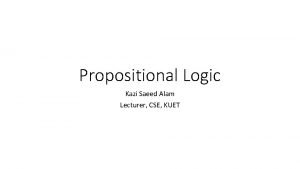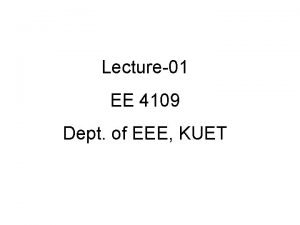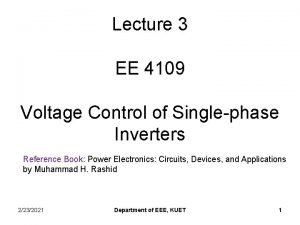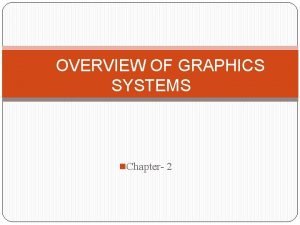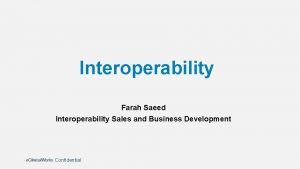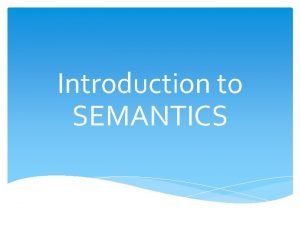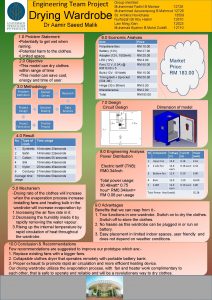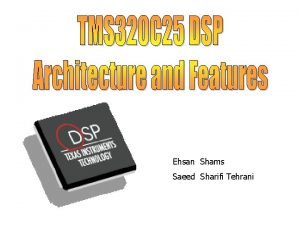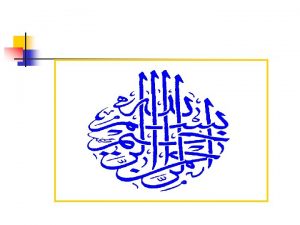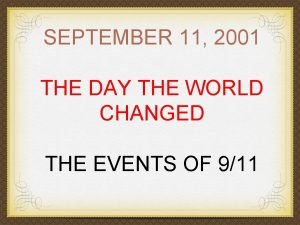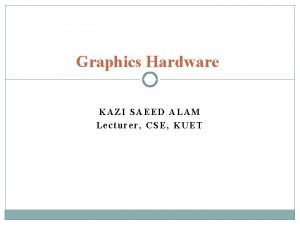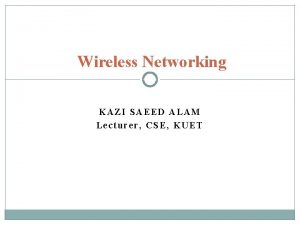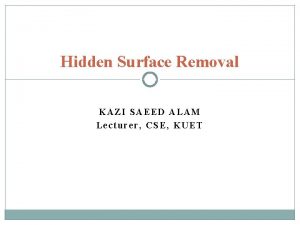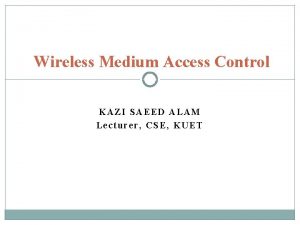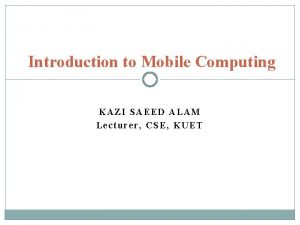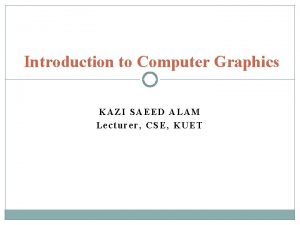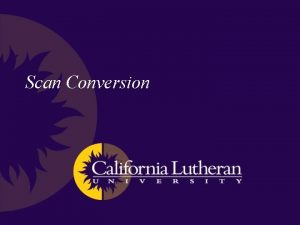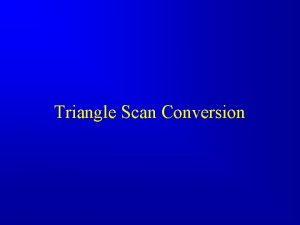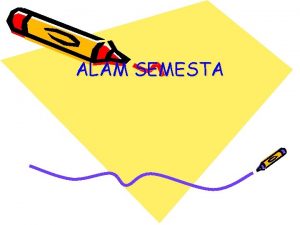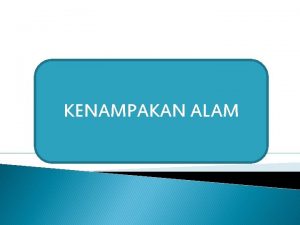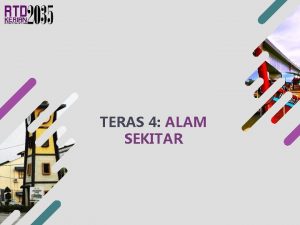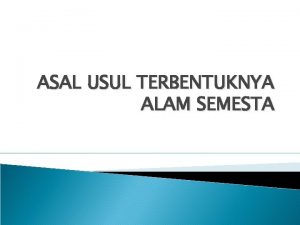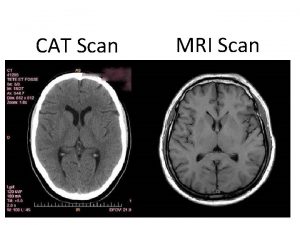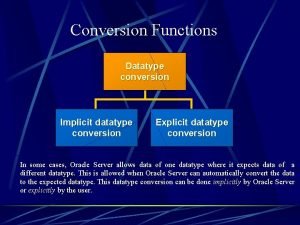Scan Conversion KAZI SAEED ALAM Lecturer CSE KUET

















- Slides: 17

Scan Conversion KAZI SAEED ALAM Lecturer, CSE, KUET

Output Primitives 2 � Basic geometric structures used to describe scenes. � Can be grouped into more complex structures. � Each one is specified with input coordinate data and other information about the way that object is to be displayed. � Examples: point, line and circle each one with specified coordinates. � Construct the vector picture. Scan Conversion 12 -Dec-21

Digital Representation 3 � Display screen is divided into scan lines and columns. � Pixels positions are referenced according to scan line number and column number (columns across scan lines). Scan lines start from 0 at screen bottom, and columns start from 0 at the screen left side. � Screen locations (or pixels) are referenced with integer values. � The frame buffer stores the intensities temporarily. � Video controller reads from the frame buffer and plots the screen pixels. Scan Conversion 12 -Dec-21

Digital Representation(cont. ) 4 � A line segment in a scene is defined by the coordinate positions of the line end-points. y (7, 5) (2, 2) x Scan Conversion 12 -Dec-21

Digital Representation(cont. ) 5 � But what happens when we try to draw this on a pixel based display? � How do we choose which pixels to turn on? Scan Conversion 12 -Dec-21

Scan Conversion 6 � The process of representing continuous graphics object as a collection of discrete pixels is called Scan Conversion. � For e. g a line is defined by its two end points & the line equation, where as a circle is defined by its radius, center position & circle equation. � It is the responsibility of graphics system or the application program to convert each primitive from its geometric definition into a set of pixels that make up the primitive in image space. This conversion task is generally referred to as a scan conversion or rasterization. Scan Conversion 12 -Dec-21

Scan Conversion(cont. ) 7 • Drawing lines, circles, and etc. on a grid implicitly involves approximation. • Ideally, the following properties should be considered – smooth – continuous – pass through specified points – uniform brightness – efficient Scan Conversion 12 -Dec-21

Scan Converting a Point 8 � A mathematical point (x, y) where x & y are real numbers within an image area, needs to be scan-converted to a pixel at location (x’, y’). � Can be done by making x’ & y’ to be the integer part of x & y. x’= Floor(x) and y’= Floor(y) P 1(1. 7, 0. 8) is represented by pixel (1, 0) P 2(2. 2, 1. 3) and P 3(2. 8, 1. 9) are both represented by pixel (2, 1). Scan Conversion 12 -Dec-21

Scan Converting a Point(cont. ) 9 � Another approach is to scan convert (x, y) by making x’ = Floor(x + 0. 5) and y’ =Floor(y+0. 5). Points P 1 and P 2 are now both represented by pixel (2, 1) whereas point P 3 is represented by pixel (3, 2). � This essentially places the origin of the coordinate system for (x, y) at the center of pixel(0, 0). Scan Conversion 12 -Dec-21

Scan Converting a Line 10 � A line is defined by its two end points & the slope intercept equation for a line: y = mx + b, m = Slope of the line, b = the y intercept of a line � Line drawing is done by: Calculating intermediate positions between the endpoints. Directing the output device to fill in the calculated positions as in the case of plotting single points. Scan Conversion 12 -Dec-21

Scan Converting a Line(cont. ) 11 � Plotted positions may be only approximations to the actual line positions between endpoints. A computed position (10. 48, 20. 51) is converted to pixel (10, 21). � This rounding causes the lines to be displayed with a stairstep appearance. � Stairsteps are noticeable in low resolution systems, it can be improved by: Displaying lines on high resolution systems. Adjusting intensities along line path. Scan Conversion 12 -Dec-21

Scan Converting a Line(cont. ) 12 � The Cartesian intercept equation for a straight line: y= m. x +b � For line segment starting in (x 1, y 1) and ending in (x 2, y 2), the slop is: m= (y 1 -y 2)/(x 1 -x 2) b= y 1 - m. x 1 � For any given x interval Δx, we can compute the corresponding y interval Δy: Δy= m. Δx � Or x interval Δx from a given Δy: Δx= Δy/m Scan Conversion 12 -Dec-21

Scan Converting a Line(cont. ) 13 � On raster systems, lines are plotted with pixels, and step sizes in the horizontal and vertical directions are constrained by pixel separations. � Scan conversion process samples a line at discrete positions and determine the nearest pixel to the line at each sampled position. (Incremental Fashion) Scan Conversion 12 -Dec-21

Line Drawing - Algorithm 1 14 • A Straightforward Implementation Draw. Line(int x 1, int y 1, int x 2, int y 2, int color) { float y; int x; for (x=x 1; x<=x 2; x++) { y = y 1 + (x-x 1)*(y 2 -y 1)/(x 2 -x 1) Write. Pixel(x, Round(y), color ); } }

Line Drawing - Algorithm 2 15 • A Better Implementation Draw. Line(int x 1, int y 1, int x 2, int y 2, int color) { float m, y; int dx, dy, x; dx = x 2 - x 1; dy = y 2 - y 1; m = dy/dx; y = y 1 + 0. 5; for (x=x 1; x<=x 2; x++) { Write. Pixel(x, Floor(y), color ); y = y + m; } }

Line Drawing Algorithm Comparison 16 � Advantages over Algorithm 1 eliminates multiplication improves speed � Disadvantages round-off error builds up get pixel drift rounding and floating point arithmetic still time consuming works well only for |m| < 1 need to loop in y for |m| > 1 need to handle special cases

Reference 17 � Computer Graphics o o R. Plastock, Zhigang Xiang (Schaum’s Outline Series) Mc. Graw Hill Scan Conversion 12 -Dec-21
 Lecturer's name
Lecturer's name Kuet cse
Kuet cse Kuet eee
Kuet eee Kuet angle
Kuet angle Cathode ray tube in computer graphics
Cathode ray tube in computer graphics The frame rate of a random scan architecture is 60-80 hz
The frame rate of a random scan architecture is 60-80 hz Dvst stands for in computer graphics
Dvst stands for in computer graphics Raster and random scan
Raster and random scan Dr farah saeed
Dr farah saeed Three challenges in doing semantics
Three challenges in doing semantics Dr aamir saeed
Dr aamir saeed Saad azhar saeed ucp
Saad azhar saeed ucp Saeed sharifi
Saeed sharifi Antifungal drugs classification
Antifungal drugs classification Dr ayaz saeed
Dr ayaz saeed Saeed khan wayne state
Saeed khan wayne state Dr ayaz saeed
Dr ayaz saeed Saeed al ghamdi
Saeed al ghamdi

